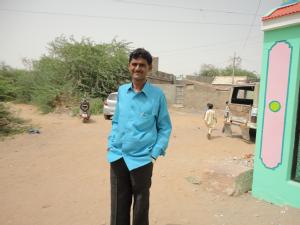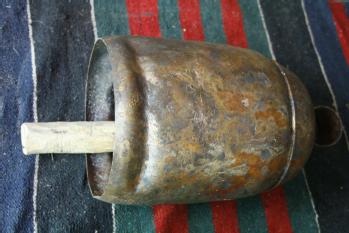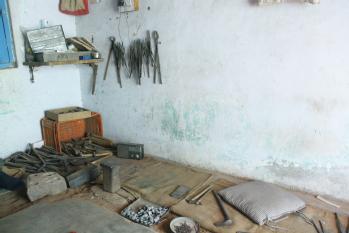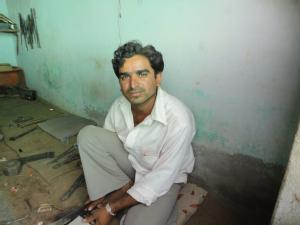Jan Mohammed and Kanji Devji Maheshwari
|
Kanji Devji Maheshwari and Occupation: Kharki or bell making Age: 26 and 34 Education: Class 4 and Class 7 Residence: Zura Date of interview: 26/5/2012 |
Kanji Devji |
Interview Summary
The bell-making craft of Kutch originated in Sindh, over a thousand years ago. According to Janmamad’s account, his family has a hundred-year association with the craft. The bell makers are usually from the Lohar or Luhar community in Kutch. The bells are popularly used by cattle herding communities not only to identify their herds but also to trace the whereabouts of lost cattle. Tied around the neck of cattle, the bells also act as a symbol of the owners’ adoration of their prized possession. Many other locals also hang bells at their doors to ward off negativity or evil spirits.
26-year-old Kanji, who makes bells for Janmamad, has worked in the profession for around fourteen years. Originally from Zura, Kanji was educated to class four. He took approximately twelve months to learn his trade, and now he is capable of making twenty-five to thirty bells per day. Working seven-hour days, he can earn around 150 to 200 Rupees for a day’s work. He says he does not know much about the market value of the products he makes. In addition to Kanji, there are four more workers who make bells for Janmamad. There is a high risk of getting injured if the correct procedures are not followed carefully, as the tools used, Janmamad tells us, are dangerous (khatrnak).

Janmamad and Kanji went on to explain the first stage of bell-making. The whole process is quite complex: it is broadly divided into two stages, carried on at two different places. Stage one is completed in small, low-tech, local workshops. Here, the bell makers hire daily labourers, both Hindu and Muslim. The labourers, like Kanji, make bells out of carefully-selected iron sheets. The thickness of the sheet used depends on the type of bell involved. First, the body of a bell is made by shaping the rectangular strips of iron plates (bhabri) into a cylindrical hollow. A round shape is obtained using a parkar (compass), and the kapani (cutter) is used for cutting. The iron strips are skilfully interlocked together without any kind of welding, but are beaten and worked into the required shape. The cylindrical body is then topped with a semi-circular hollow crown made from a small iron strip with an instrument that Janmamad identifies as paroni and dholan hathodi (hammer). The sheets are moulded with the help of ekelvahi, and joined by making proportionate khapa,or slits. Joining tools such as parkaor farka and miksandha are also used. For the next step, kado is inserted to fix the clapper (kani) that makes the sound of the bell itself. They are then coated with powdered copper with the help of mud paste and heated in a furnace to fix the powdered copper on to the surface of the bell. Before putting the raw bell for final firing a bhatthi (bricked furnace), all in all five substances - copper, brass, cotton (kapas), sarakhand clay – are used to create the finish. The textured and burnished copper coatings range from tan-yellow gold to a red-brown gold.
The women of the Lohar families are heavily involved in the finishing process. The clay coating which binds the metals together is made by the women of the household, and they also make circular rotis to cover the bell. Janmamad frankly admits that in this second stage, forty per cent of the bell-making work is done by his wife, mother and his brother Rajak’s wife.
For heating the bells, the craftsmen work during the cool hours of the day to avoid the extreme afternoon heat. Once cooled and ready, denting the bell, which is known as dhak, to ensure a melodious echo is also done by hand, by repeated beating with a hammer. This takes a lot of expertise, a sensitive touch, and careful listening.
 There are various sizes of bells (starting at 'size zero') with different sounds and pitches. According to Janmamad, a goat would have a small bell, perhaps numbering four, with a high pitched sound; while a cow would have a much larger one with a deeper note known as ghangani. The prices also vary from minimum of 25 Rupees to 1500 depending on the size. The bell makers take custom orders as per the requirements of their buyers. Polishing and embellishments add decorative touches to an otherwise plain product. Janmamad is an expert in the art of metallurgy, but also possesses musical knowledge. This ability to tune bells is a skill Janmamad claims he is born with, and he considers it God’s gift.
There are various sizes of bells (starting at 'size zero') with different sounds and pitches. According to Janmamad, a goat would have a small bell, perhaps numbering four, with a high pitched sound; while a cow would have a much larger one with a deeper note known as ghangani. The prices also vary from minimum of 25 Rupees to 1500 depending on the size. The bell makers take custom orders as per the requirements of their buyers. Polishing and embellishments add decorative touches to an otherwise plain product. Janmamad is an expert in the art of metallurgy, but also possesses musical knowledge. This ability to tune bells is a skill Janmamad claims he is born with, and he considers it God’s gift.
Since iron and even brass scraps purchased from the junkyards of Jamnagar (Gujarat) are used in making these bells, the craft can be categorised as a sustainable one. The indigenous furnaces used consume little energy and also generate little waste, comprising only a minuscule quantity of metal scraps and burnt mud.
According to Janmamad, tourism has had an indirect impact on their trade; occasionally taxi drivers drop tourists at their doorstep. For the most part, their orders are generated through exhibitions held at large metro cities however. Janmamad has registered with the organisers of the exhibition and whenever exhibitions are held they receive an invitation to attend. Internationally, his most prized customers are from Denmark, famous of course for its cattle-raising and dairy industry. From Denmark, Janmamad gets assured special orders that he is extremely satisfied with. Local demand comes primarily from the cattle herding communities of Kachchh; the Maldharis or Rabari. Janmamad adds that whenever the rains are plentiful, demand increases, and vice versa. The bell makers pray for a fair monsoon to get a good order from the Rabaris.
Jan’s products comprise not just bells, but range from wind chimes to expansion wheels and Hindu religious symbols such as Om and Sathia. Their craft continues all year round, except for April and June, and caters for almost continuous demand. He also has a plan to renovate his workshop in order to display his finished products. As well as monetary benefits, the craft earned him state level honours in 2010. Aware of how many entries there are at the national level Janmamad is not expecting national award in a near future but may try nevertheless. He proudly adds that “Zure jedo kam koi na kare” (no one can produce as high-quality work as Zura).
 For the furnace, only particle coal (mamri) that burns at a lower temperature is used. This stops the bell burning and turning too dark. However, this coal dust also creates breathing problem and continually sitting near the furnace also affects the eyes of the bell makers. Despite such problems, they neither cover the mouth nor wear protective eyewear, both for comfort and to ensure unobstructed vision. Machinery is used at certain stages of the manufacturing process. For polishing, Janmamad says that a kanas used to be used, but that it is now done by machine to achieve a highly polished finish. This has brought around a fifty per cent increase in production as the bells can be polished much quicker. With the help of machinery then, output and quality have both increased. Janmamad told us that an electric furnace can solve the problem of both speed and health. Yet, he is unsure over the benefits of investing. For a complete and even bake the bell must be kept revolving and Janmamad doubts whether a small electric furnace would facilitate this revolving process. Another concern is finance, as Janmamad estimates that it may cost around four to five lakhs to purchase.
For the furnace, only particle coal (mamri) that burns at a lower temperature is used. This stops the bell burning and turning too dark. However, this coal dust also creates breathing problem and continually sitting near the furnace also affects the eyes of the bell makers. Despite such problems, they neither cover the mouth nor wear protective eyewear, both for comfort and to ensure unobstructed vision. Machinery is used at certain stages of the manufacturing process. For polishing, Janmamad says that a kanas used to be used, but that it is now done by machine to achieve a highly polished finish. This has brought around a fifty per cent increase in production as the bells can be polished much quicker. With the help of machinery then, output and quality have both increased. Janmamad told us that an electric furnace can solve the problem of both speed and health. Yet, he is unsure over the benefits of investing. For a complete and even bake the bell must be kept revolving and Janmamad doubts whether a small electric furnace would facilitate this revolving process. Another concern is finance, as Janmamad estimates that it may cost around four to five lakhs to purchase.
So far, Janmamad has trained three or four others in his craft. He has taught a number of interested individuals informally, and a batch of ten students are currently under his tutelage as part of a central government sponsoring scheme. Janmamad also told us about his village Zura. Zura is a small village in Bhuj taluka (division) and has a population of 5,000. Out of those, around 23 follow the craft of bell making. Zura’s neighbouring village of Nirona also has many proficient bell-makers, many of whom migrated from Zura. Janmamad is the current President of Zura lohari kamudhyog and represents the workers in matters concerning their craft. He looks after the welfare of his fellow professionals but has yet to encounter any disputes.

